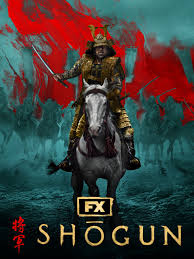from New York Times:https://www.nytimes.com/2024/02/26/arts/television/shogun-review.html

‘Shogun’ Review: Rediscovering Japan
The FX remake of the classic mini-series is classed up, retuned for contemporary sensibilities and still an epic soap opera.
By Mike Hale
Published Feb. 26, 2024Updated Feb. 28, 2024
The new FX mini-series “Shogun” is getting a lot of credit simply for not being “Shogun,” the 1980 NBC mini-series also adapted from James Clavell’s best-selling novel about the last days of feudal Japan. But the new show stands and falls on the same terms as the old show: its success as an epic costumed soap opera. You can correct for wooden acting, dated production values and Eurocentrism, but you can’t really correct for the basic nature of the material.
And on those terms, this “Shogun” — which premieres Tuesday on FX and Hulu with two of its 10 episodes — is perfectly successful. It is sumptuously produced, mostly well acted and not excessively sentimental or sensational. If its story seems to stop and start a bit, there are reasons for that, which become clear in a satisfying and moving ending; if there are major characters who don’t stand up to scrutiny, there are others who come alive and hold your interest. It may not live up to its hype, and it may leave you wondering why so much time (more than a decade) and money needed to be spent reanimating Clavell’s tale. But it delivers.
Created by the husband-and-wife team of Justin Marks and Rachel Kondo, the FX “Shogun” is still the story of an English navigator, John Blackthorne, who arrives in Japan at the turn of the 17th century and becomes embroiled — to a startling degree — in the political, cultural and romantic life of the country. (Blackthorne, like most of the significant characters, is loosely based on a historical figure.)
Kondo and Marks have recalibrated the narrative, however, moving Blackthorne’s point of view down in the mix and elevating the roles of many of the Japanese characters, particularly Toda Mariko, the noblewoman who becomes Blackthorne’s translator and love interest, and Yoshii Toranaga, the lord who both protects and manipulates him.
That’s a notable change from the original “Shogun,” but 44 years down the road, it’s not as if the show should get a ton of credit — it’s an easy win. In the current global TV environment, the show’s emphasis on Japanese characters and language is welcome but not exceptional. (Tremendous effort reportedly also went into vetting the details of period costume and behavior; few viewers, even in Japan, are likely to know the difference, but what’s onscreen certainly looks credible to the rest of us.)
As the plot, busy yet not all that complicated, unwinds — Toranaga and his rival Ishido jockeying for power, with Blackthorne as a reluctant pawn; Blackthorne being alternately repulsed and seduced by his new surroundings — the real difference between the old and new shows has less to do with cultural enlightenment than with a higher level of tastefulness and technique. Though there is a multicultural dimension there, too: Marks and Kondo’s show is informed by the craftsmanship of classic Japanese samurai films, which were in turn heavily influenced by the attitudes and styles of Hollywood westerns and swashbucklers. This “Shogun” sits in a polyglot comfort zone.
Not everything has been improved. Cosmo Jarvis (“Lady Macbeth”), stepping in for Richard Chamberlain as Blackthorne, seems just as lost as his stranded, bewildered character. He works a dull note of dazed petulance for much of the series, eventually shifting to stunned sorrow. While the story builds Blackthorne up — he is continually (improbably) saving the day — Jarvis’s lack of presence works against the narrative, making Mariko’s attraction to Blackthorne and Toranaga’s sympathy for him hard to buy.
We stay engaged, though, because the actors Jarvis is matched against easily hold our attention. Anna Sawai, who did not quite click as a contemporary action hero in “Monarch: Legacy of Monsters,” is thoroughly convincing and captivating as Mariko. And Hiroyuki Sanada carries the show as the relentlessly pragmatic, humanely inhumane Toranaga; he is not the most expressive of actors, but he has a quiet force and regality that fit the part.
A number of the supporting players are also excellent, beginning with the Japanese film mainstay Tadanobu Asano as the scheming daimyo Yabushige and including Takehiro Hira as Ishido, Moeka Hoshi as Blackthorne’s consort and Tokuma Nishioka as Toranaga’s most loyal retainer.
The roles those performers play so capably are familiar ones, and if the creators of the show display an increased sensitivity to stereotypes, that does not prevent this “Shogun” from exhibiting signs of a familiar cinematic Japonisme. It’s there in the fetishization of death (seppuku recurs) and the central contrast of Blackthorne’s Western individualism with the Japanese characters’ devotion to duty and sacrifice. Sex is aestheticized; a maid is a member of a secret assassin’s guild (though the character is no longer a full-on ninja, as in 1980). Dialogue keeps blossoming into poetry.
All these things may be historically and culturally accurate to some degree, but they are also undeniably the tropes of Western romanticization of Japan. And at the end of the day, “Shogun” — if it stays tied to Clavell’s book at all — remains a prime example of the Westerner’s attempt to encapsulate his fascination, or infatuation, with Japanese style and attitude.
So why go to so much trouble to spruce up a British writer’s half-century-old fantasy of Japanese history? It may be defensible only in commercial terms. But when Toranaga and Yabushige meet on a cliff in the rising sun and explain what the whole story has been about, Sanada and Asano glide past all those paltry concerns.
No comments:
Post a Comment